Calling all weekend warriors! Are you looking for a jam-packed weekend adventure in the UK?
Up and down the UK, inviting towns and quaint villages are nestled at the foot of some of our finest landscapes, just waiting to welcome you.
From the bustling village of Castleton to the adventure capital of Eryri, Beddgelert, these bases are the best places from which to find walking route and biking trails directly into high places, as well as a plethora of other outdoor activities from paddleboarding to paragliding. We’ve also included the best local spots to put your feet up, eat some good grub and enjoy a drink – as well as places to lay to your head, from budget to luxury.
If you’re looking for more of an extended journey, have a look at our pick of the UK and Ireland’s best long-distance walking routes for inspiration.
The best adventure towns and villages in the UK
- Aviemore, Cairngorms National Park, Scottish Highlands
- Newcastle, Mourne Mountains, Northern Ireland
- Wooler, Northumberland, England
- Keswick, Lake District, England
- Castleton, Peak District, England
- Postbridge, Dartmoor, England
- Beddgelert, Eryri (Snowdonia), Wales
- Crickhowell, Bannau Brychieniog (Brecon Beacons), Wales
Aviemore, Cairngorms National Park
As the de facto ‘capital’ of the Cairngorms National Park, Aviemore is an ideal hub for a weekend exploring in the Scottish Highlands. James Roddie is your guide.
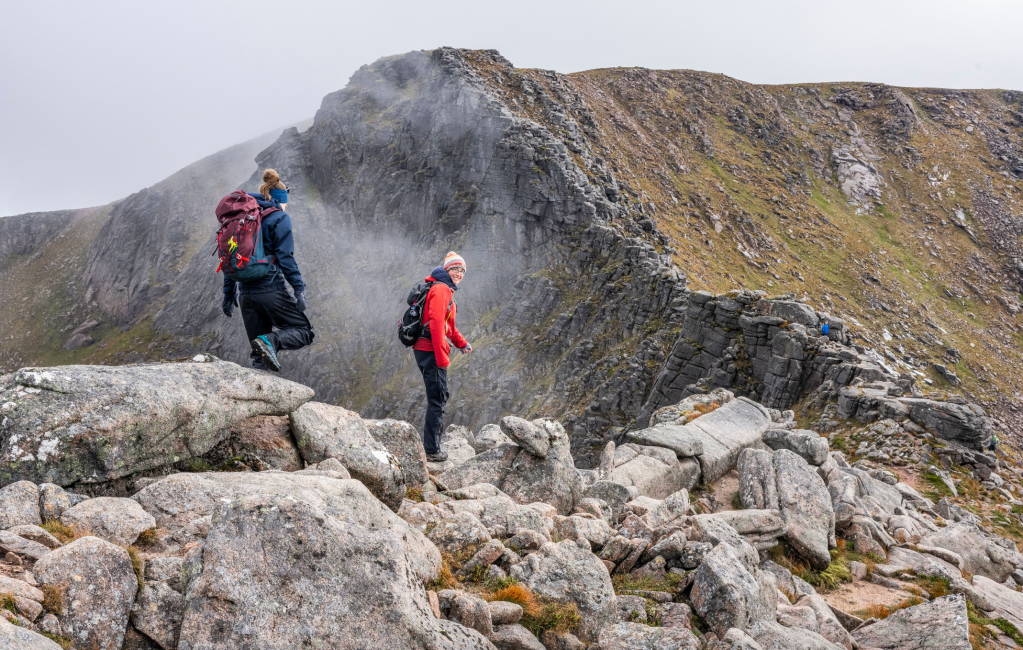
A chilly day on Fiacaill Ridge. Credit: James Roddie
Aviemore is justifiably one of the most popular destinations for outdoor recreation in the Scottish Highlands. As the de facto ‘capital’ of the Cairngorms National Park, it is a busy and bustling place for much of the year, but it is hard to beat as somewhere to base yourself for a weekend in the outdoors. There really is something for everyone here.
You barely have to leave the town before entering Rothiemurchus Forest – one of the largest areas of ancient Caledonian woodland remaining in Scotland. The forest here really is special, and it is common to spot red squirrels amongst the pine trees, or ospreys flying overhead. There is an extensive network of footpaths and cycling trails throughout Rothiemurchus and neighbouring Abernethy Forest. You can easily find solitude only a few minutes from the town centre.
A cycle or drive of 7 miles from Aviemore brings you to Loch Morlich, a popular spot for sailing, kayaking and swimming. Looming over the loch beyond is the main event – the Cairngorm plateau.
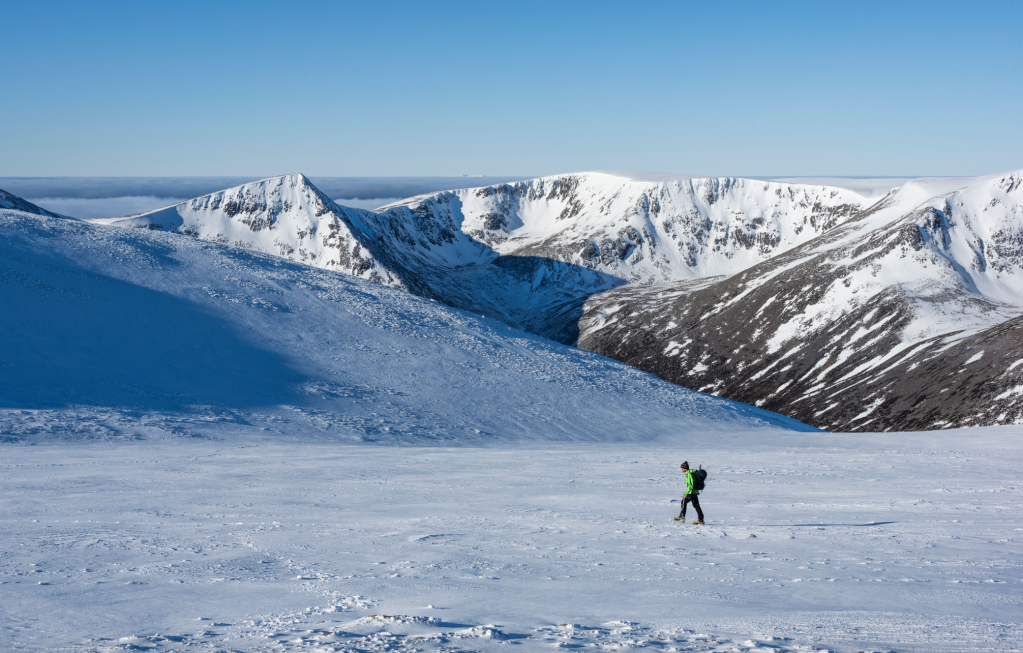
Climbing Ben Macdui in winter. Credit: James Roddie
The summits and corries here are a much-loved area for hill walking, skiing and winter climbing. Several of the highest Munros can be ‘bagged’ in a weekend, thanks to the ski centre car park at 600m altitude at Cairngorm Mountain Resort. The ski centre has divided opinion for years, but love it or hate it, the approach road allows some of the most easily accessible hillwalking and climbing anywhere in Scotland. Whilst it can get very busy around the ski centre, you don’t have to walk far until you are in quiet, serious mountain backcountry.
Only a few miles south of Aviemore lies Glen Feshie. This is easily one of the most beautiful of all Scottish glens. Extensive rewilding efforts have allowed the forest to flourish and extend up the hillsides once more. Several Munros are reached via walks from Glen Feshie, and energetic mountain bikers will find challenging routes to keep them entertained. If you just want some quiet and solitude, then the glen itself is a fine place to enjoy a wild camp amongst the pine trees.
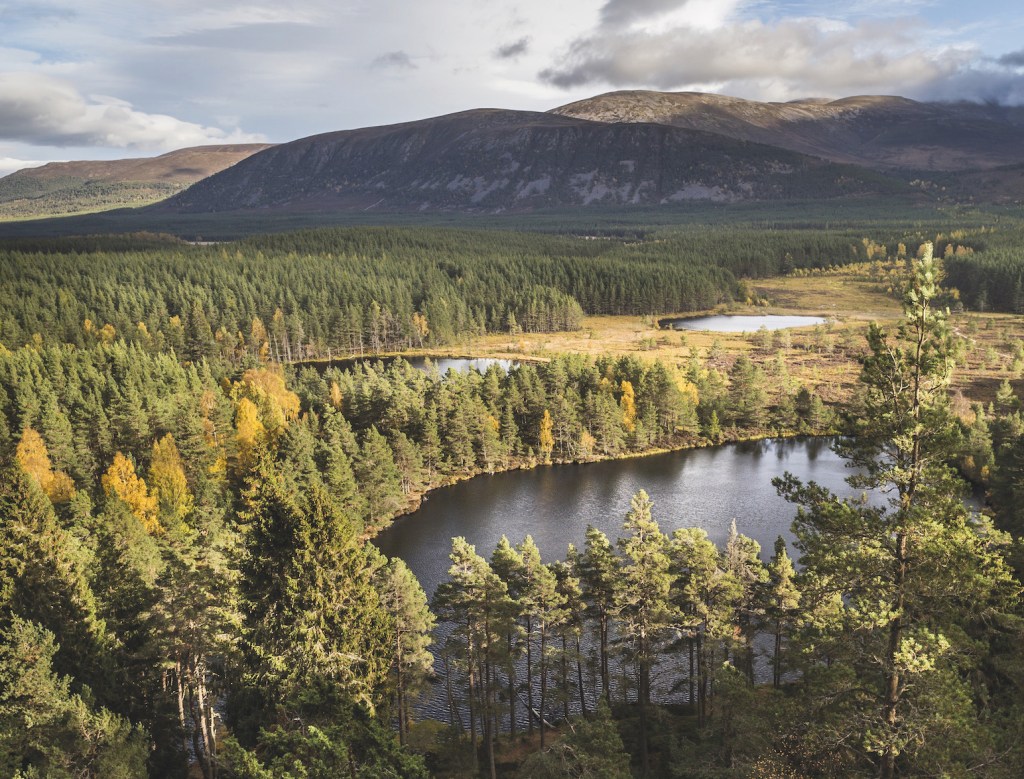
The Uath Lochans in Glen Feshie. Photo: Shutterstock
If the weekend weather ends up being unkind then there is plenty to do away from the hills. The RSPB Loch Garten Nature Centre is well worth a visit in the summer months – most years there are nesting ospreys visible from the centre. The Highland Folk Museum and the Highland Wildlife Park are also close by, and both are great options for a family day out.
Learn more about having a jam-packed adventure weekend in Aviemore from our contributor, James Roddie.
Newcastle, Northern Ireland
The seaside resort of Newcastle, at the foot of the Mourne Mountains in Northern Ireland, has some fantastically atmospheric hiking and hillwalking on the doorstep, says Carey Davies.
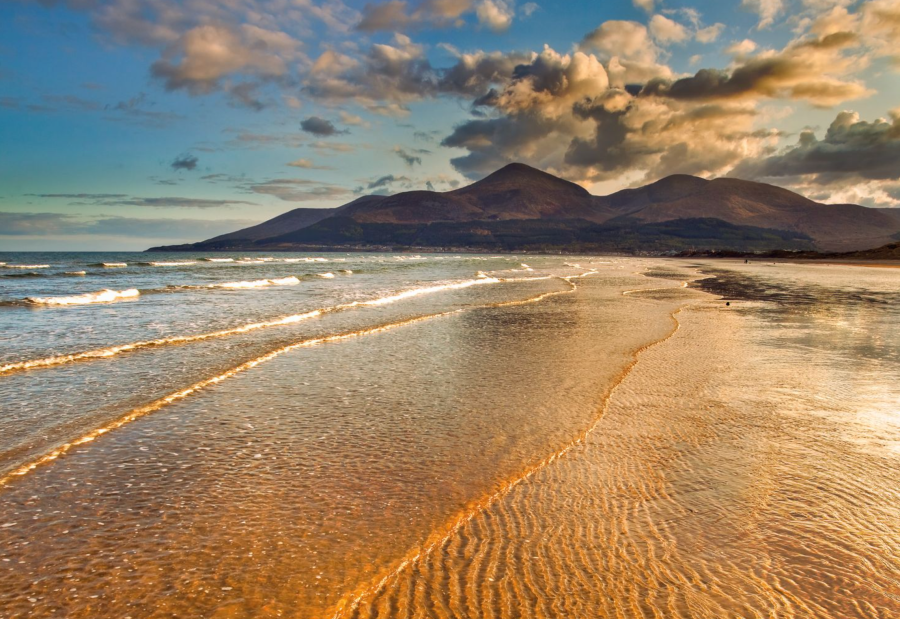
Slieve Donard spectacularly overlooks the beach at Newcastle. Credit: Shutterstock
A beautiful range of coastal granite mountains fringed by fragments of temperate rainforest, Northern Ireland’s Mourne Mountains are well-known across the island of Ireland but are arguably under-appreciated by hikers and outdoor enthusiasts on the other side of the Irish Sea. But the profile of these hills is set to be boosted by their designation as part of a UNESCO Global Geopark, in recognition of the landscape’s outstanding geological heritage; a natural inheritance which has become intertwined with the region’s history and culture in fascinating ways. Fantasy fans will also be in their element here: the Mournes were used as a suitably epic filming location in Game of Thrones, and were said to have inspired C.S. Lewis’s visions of Narnia.
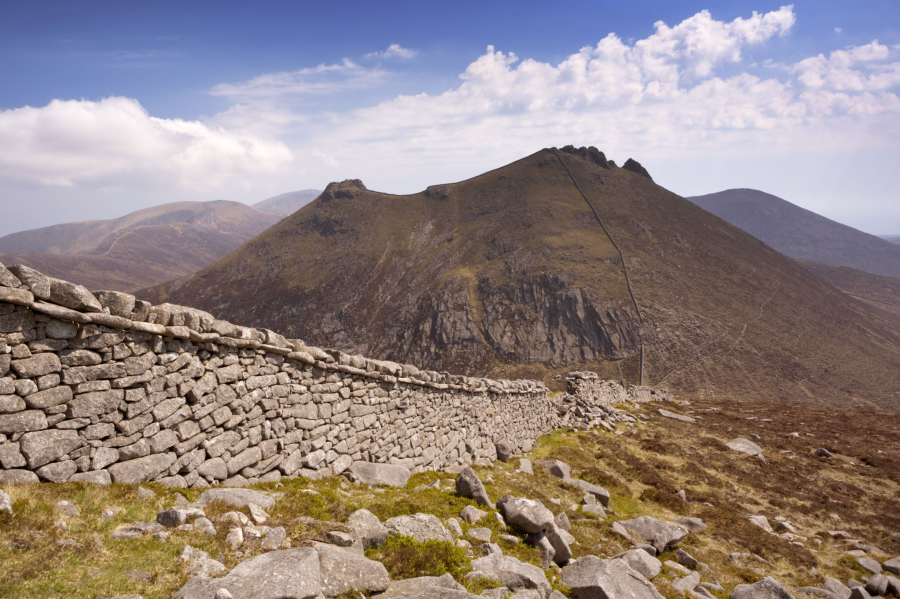
The Mourne Wall. Credit: Shutterstock
“The dark Mournes sweep down to the sea”, as the song goes, and the seaside resort town of Newcastle is a good place to appreciate this, being as it is spectacularly overlooked by the shapes of Slieve Donard, the region’s 850 metre (2,790 feet) high point, and its surrounding hills. The town promotes itself as the ‘activity resort’ of Northern Ireland, and walkers are well catered-for here, with the town and its surroundings making an excellent base for hiking and hillwalking in these rugged, heathery hills, with their broad granite backs punctuated with plunging crags and fortress-like tors. These aren’t hugely tall summits but they deliver a punch: the terrain underfoot is often challenging and walks sometimes begin from sea level, packing in the elevation. Fans of the hills of Arran – another compact range of maritime granite mountains – will likely feel at home here.
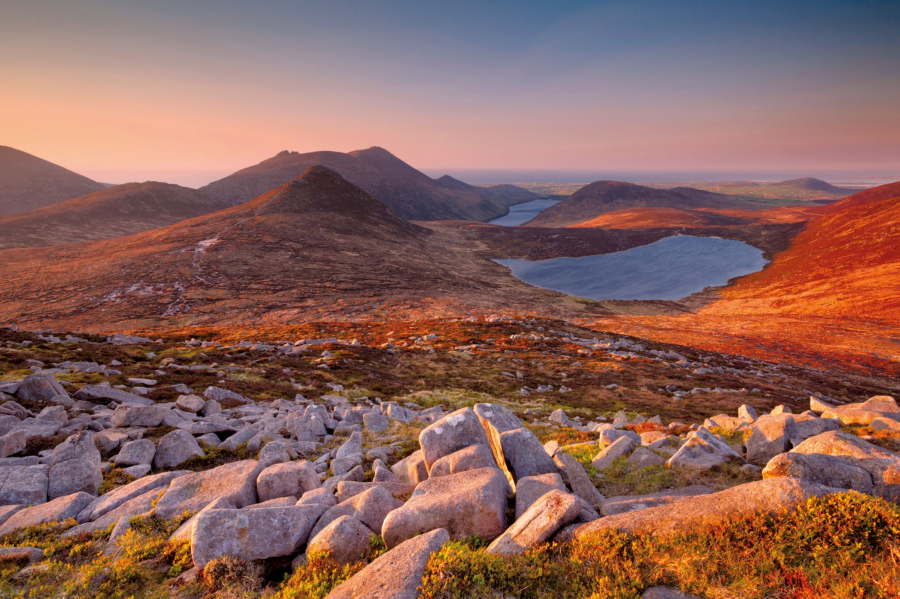
Sunrise from Slieve Loughshannagh. Credit: Shutterstock
The area around the Mournes also offers ample scope to combine your hiking with other types of outdoorsing, like mountain biking or paddleboarding. And if you want to contextualise your adventurous exploits, there’s an array of cultural activities allowing you to get an insight into the region’s history. With its array of cafes and restaurants, Newcastle is also an excellent place to dip into the thriving local culinary scene, and sample some treats with a firm rooting in the local landscape.
Learn more about having a jam-packed adventure weekend in Newcastle from our editor, Carey Davies.
Wooler, Northumberland
Straddling the England-Scotland border, the Cheviot Hills cover some of the remotest ground in England. Reaching the heart of these rolling hills requires commitment, but there is one town that makes an excellent base camp – Wooler. Vivienne Crow is your guide.
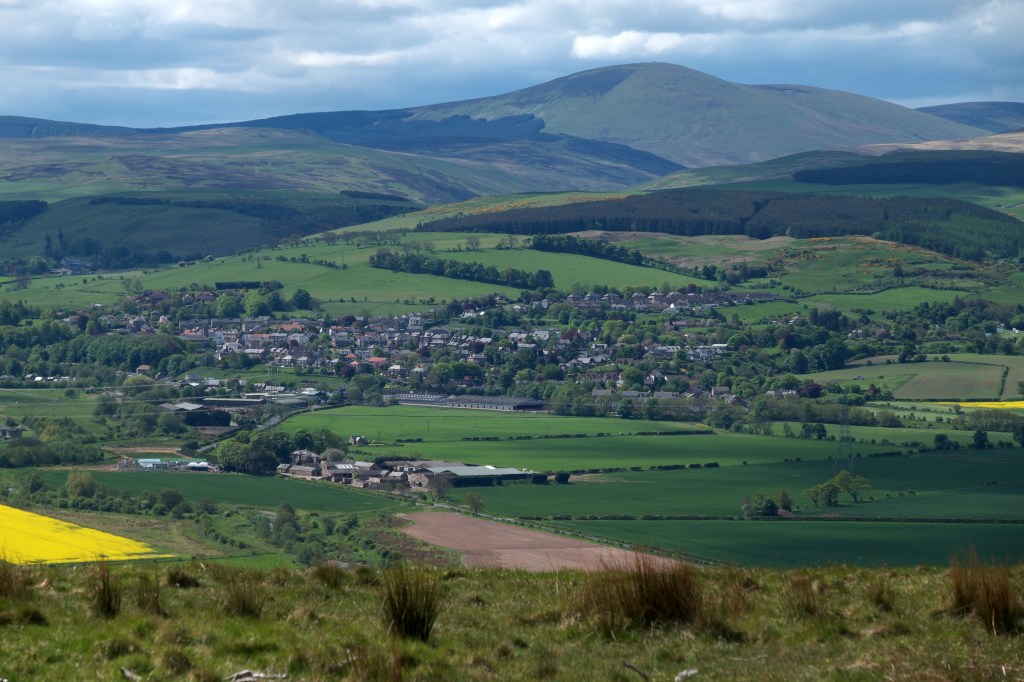
Wooler sits at the foot of the Cheviot Hills. Credit: Vivienne Crow
Located in the north-east of Northumberland, this friendly little market town sits at the base of the range, near Northumberland National Park’s northern edge. Wooler is a place that’s used to the sight of walkers marching along its High Street.
The 62-mile St Cuthbert’s Way passes through the town on its undulating way from Melrose to Lindisfarne and footpaths come and go in all directions, giving access to both low-level and more demanding walks. The peaty lump that is The Cheviot lies just seven miles away as the crow flies, although you’ll need private transport to reach the start point for most routes climbing to the county’s highest point.
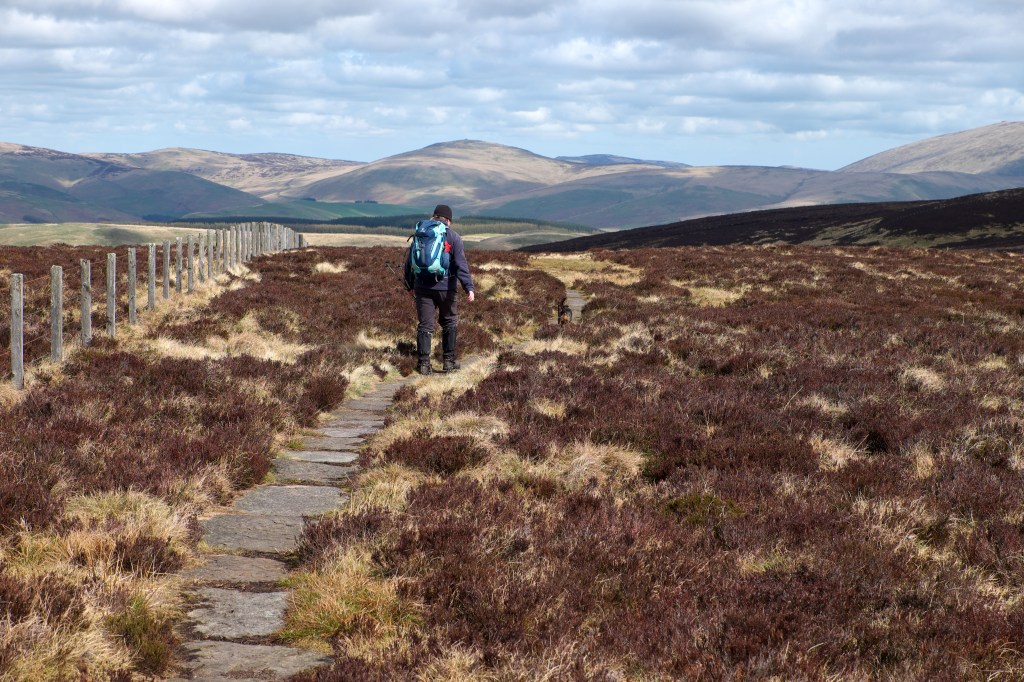
Walking the Border ridge in The Cheviot Hills. Credit: Vivienne Crow
Visitor facilities are good, with plenty of accommodation and dining options as well as a small Co-op supermarket and several independent retailers. If there’s anything else you need to know, pop into the community-run Tourist Information Centre on Padgepool Place (01668 282123). The staff there are always helpful.
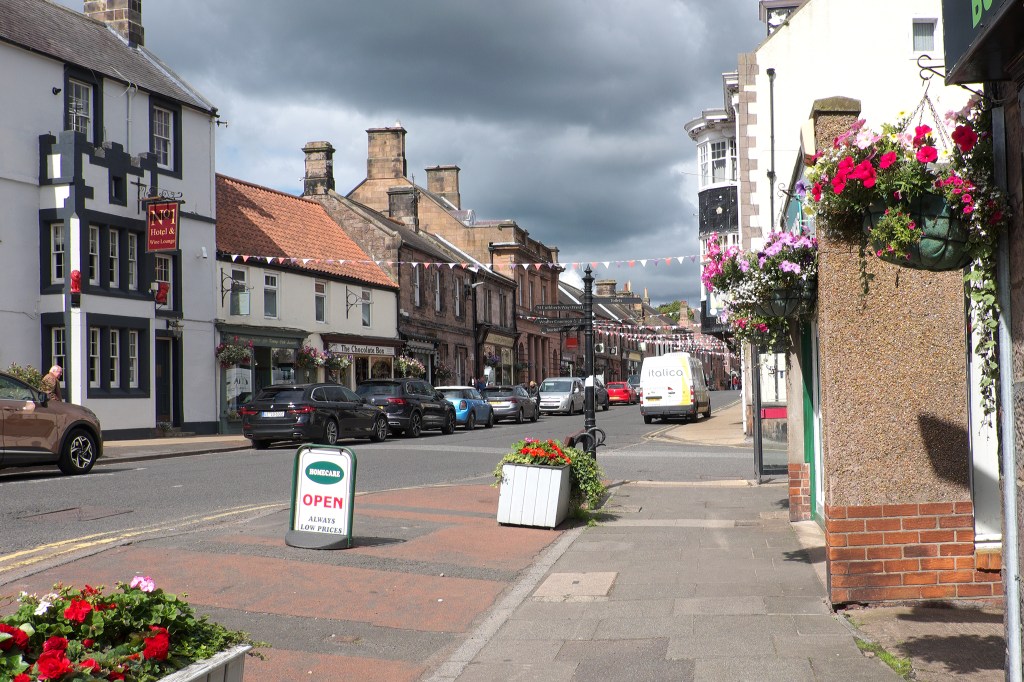
Wooler town centre. Credit: Vivienne Crow
One last thing before you lace up your boots and go, if you’ve got an hour or two to spare, Ad Gefrin is well worth visiting. This Anglo-Saxon Museum and whisky distillery opened to the public last year, and is located in a smart, new building a few minutes’ walk from the town’s Market Place.
Learn more about having a jam-packed adventure weekend in Wooler from our expert contributor, Vivienne Crow.
Keswick, Lake District
The heart of the northern Lake District has great pubs, gear shops galore, and some of England’s greatest hillwalking on its doorstep – what’s not to like, asks Vivienne Crow.
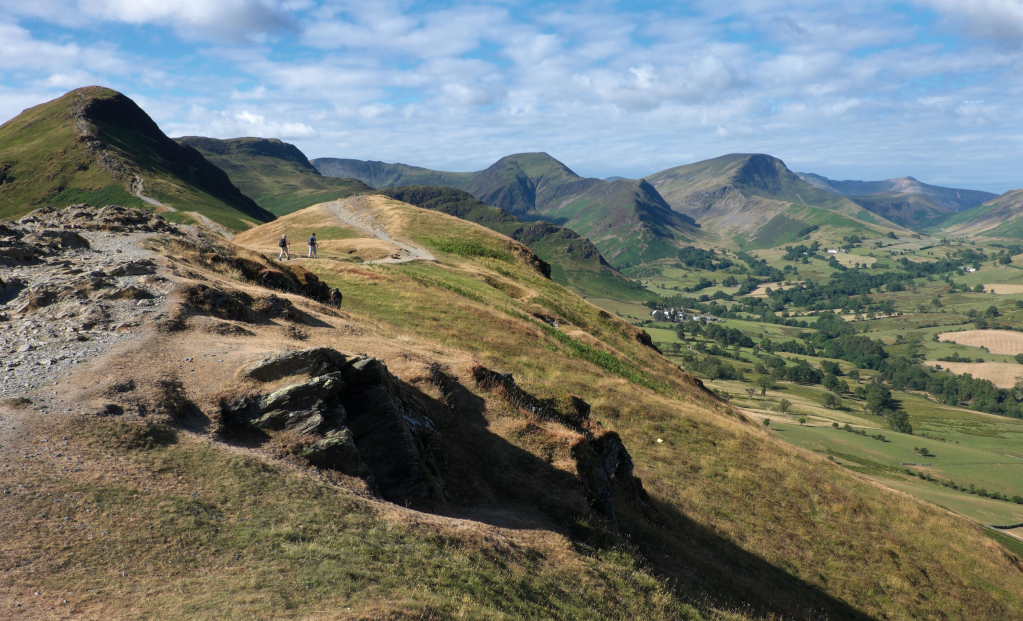
On the way up Cat Bells, with views over the Newlands fells.
Keswick may have its Victorian villas, its townhouses, its restaurants, and its smatterings of culture, but it’s got a slightly ‘harder’ feel to it than its more genteel neighbours in the South Lakes. Maybe it’s those fells, Skiddaw in particular looming over the slate roofs, its bulky mass like a 931m-tall woolly mammoth. Maybe it’s the unpredictable weather (after all, Seathwaite, England’s wettest inhabited place, is just up the road) or the town’s association with historic mining in the surrounding fells. Or maybe it was just too far for those Liverpool and Manchester industrialists who built their sprawling homes on the shores of Windermere, gentrifying the landscape ‘down there’.
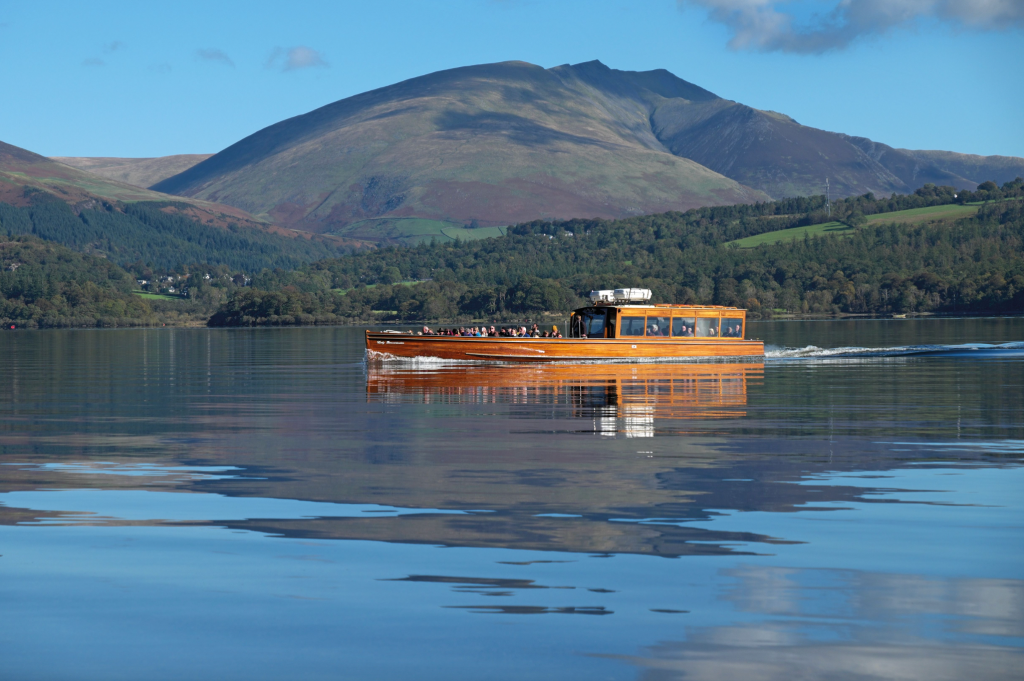
Skiddaw looms over Derwentwater.
Nevertheless, these things are relative in the Lake District, and Keswick is still one of the Lake District’s most picturesque and thriving hub towns. Casual strollers will enjoy the shores of Derwentwater, but more serious fell and mountain types – hikers, runners, climbers, mountain bikers and so on – will feel very at home here. This is the place to come to buy your ice axe and crampons, as well as your waterproof jacket or your new lightweight tent. There are outdoor gear shops galore; as local people say, plenty of places to purchase outerwear but nowhere to buy underwear (unless it’s technical merino underwear, of course!).
You can reach the fells directly from the town, with local paths providing access to circular walks on Skiddaw or the airy ridge lines of some of the classic horseshoes. Better still, local buses open up the opportunity for long, satisfying linear routes. Transport options include the 555 south along the A591 to Grasmere, Ambleside and Windermere, the 78 bus through Borrowdale as far as Seatoller and, in summer, the 77/77A circular that’ll take you to Whinlatter, Buttermere and Honister Pass. There’s also the Keswick Launch on Derwentwater.
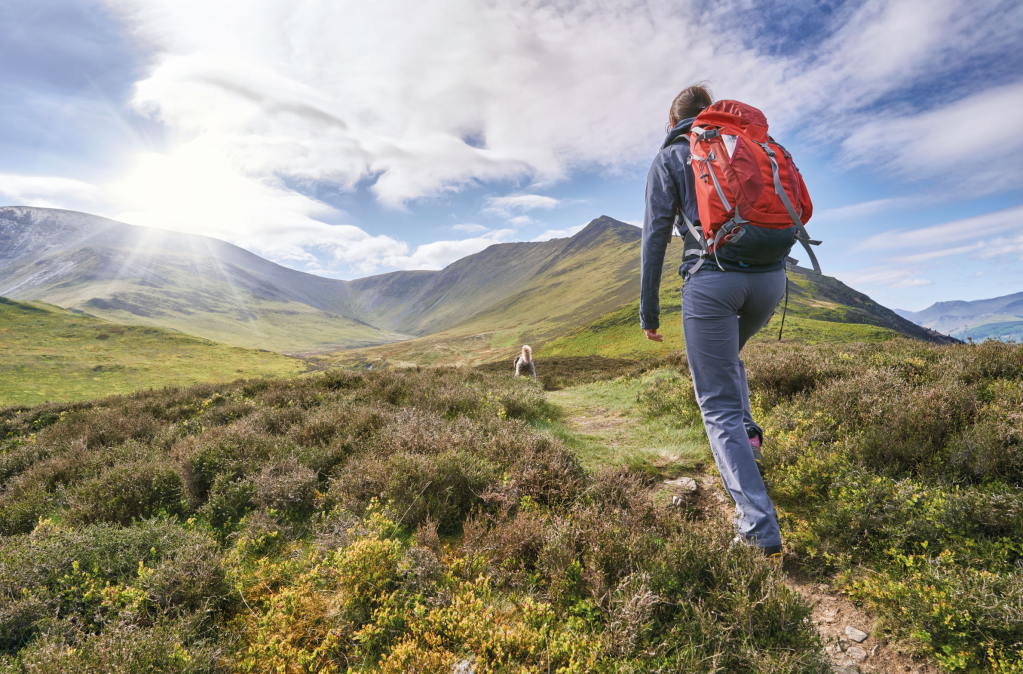
Keswick is a haven for your canine companion. Credit: Shutterstock
Before we get down to some walking, one last thing for pet owners… Keswick is doggy heaven. Thanks to its canine-convivial accommodation providers, shops, pubs and cafés, Keswick has been voted the UK’s dog friendliest town in the Kennel Club’s Open for Dogs Awards on several occasions. So, there’s nothing stopping you, is there?
Learn more about having a jam-packed adventure weekend in Keswick from our expert contributor, Vivienne Crow.
A weekend adventure in Beddgelert, Eryri (Snowdonia)
Here’s our guide to having the best possible adventurous weekend in Beddgelert. Will Renwick takes care of your itinerary.
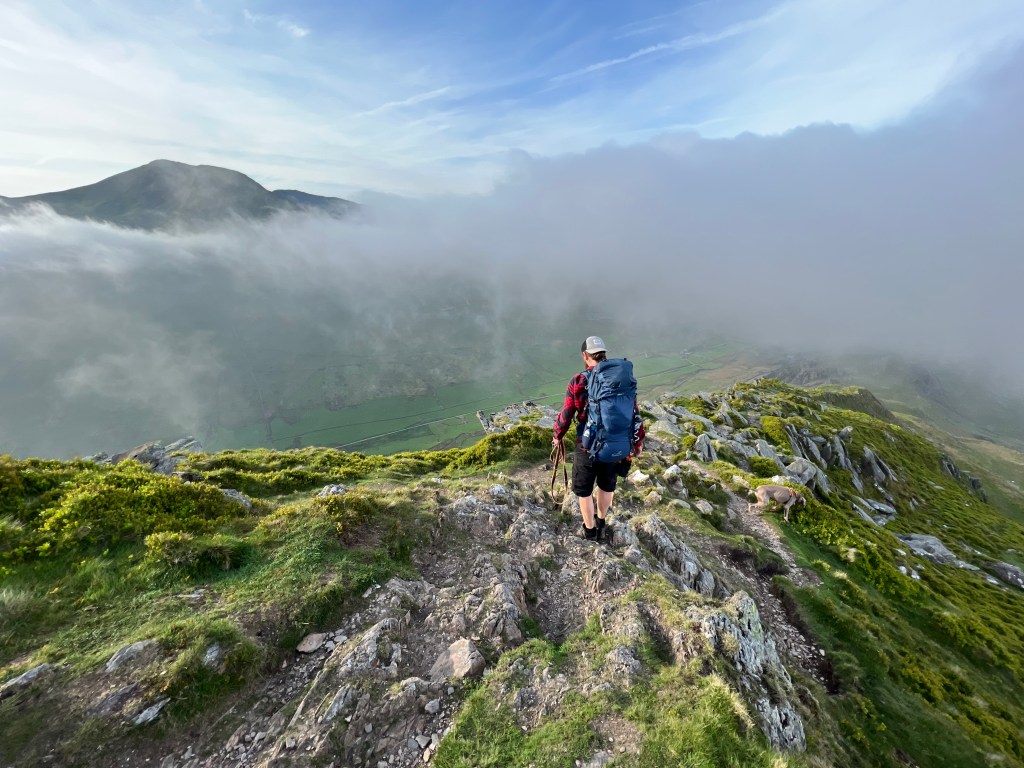
On the descent of Cnicht with Moelwyn Mawr poking out from behind the clouds. Credit: Francesca Donovan
Surrounded by steep mountains and Celtic rainforest and steeped in myth and legend, the village of Beddgelert, situated right at the foot of Yr Wyddfa (Snowdon), has been drawing outdoor enthusiasts for centuries. Follow the southbound river past the little shops and cafes and out of the village and you’ll soon find a sombre monument in the middle of a meadow. It marks the final resting place of Gelert, a wolfhound whose demise came about at the hands of his owner Llewelyn ap Iorwerth, King of Gwynedd, who slew the dog after mistakenly believing he had killed the king’s newborn baby. Fortunately, this tragic tale is in fact just a myth. The story of Gelert was, in reality, cooked up by the landlord at the nearby Royal Goat Hotel; a cunning eighteenth century marketing ploy to draw more visitors to the village.
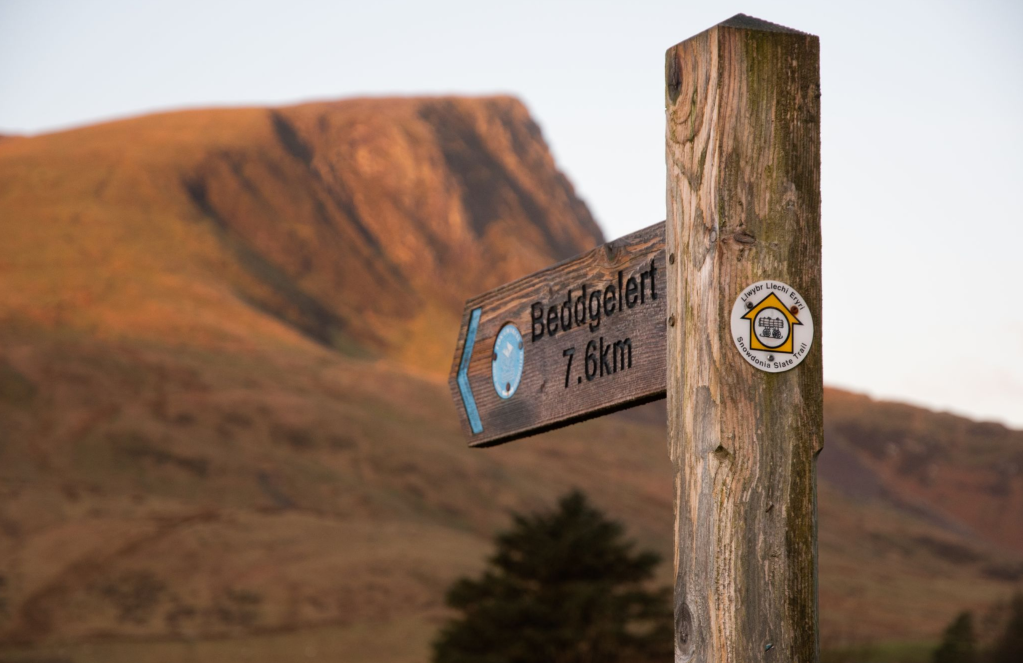
On the Snowdonia Slate Trail. Credit: Andrew Galloway
These days, the reputation of this village goes far beyond folklore. Many would argue that it’s the most picturesque village in all of Eryri (Snowdonia). On one side, looms the dorsal fin of Yr Aran, its top silhouetted by Wales highest mountain, Yr Wyddfa, while the bouldery face of Moel Hebog guards its western side. Two rivers meet in the village, the Afon Glaslyn and the Afon Colwyn. These can be foaming torrents throughout most of the year, though in summer they tend to slow down to offer irresistible pools to cool down in. With these two rivers and the roads leading north, south and east from its centre, the village has played a central role in the history of this area and the local architecture exhibits that heritage. There’s the seventeenth century bridge, for instance, and the hotch-potch stone cottages and inns that many a weary traveller would have stopped in over the centuries.
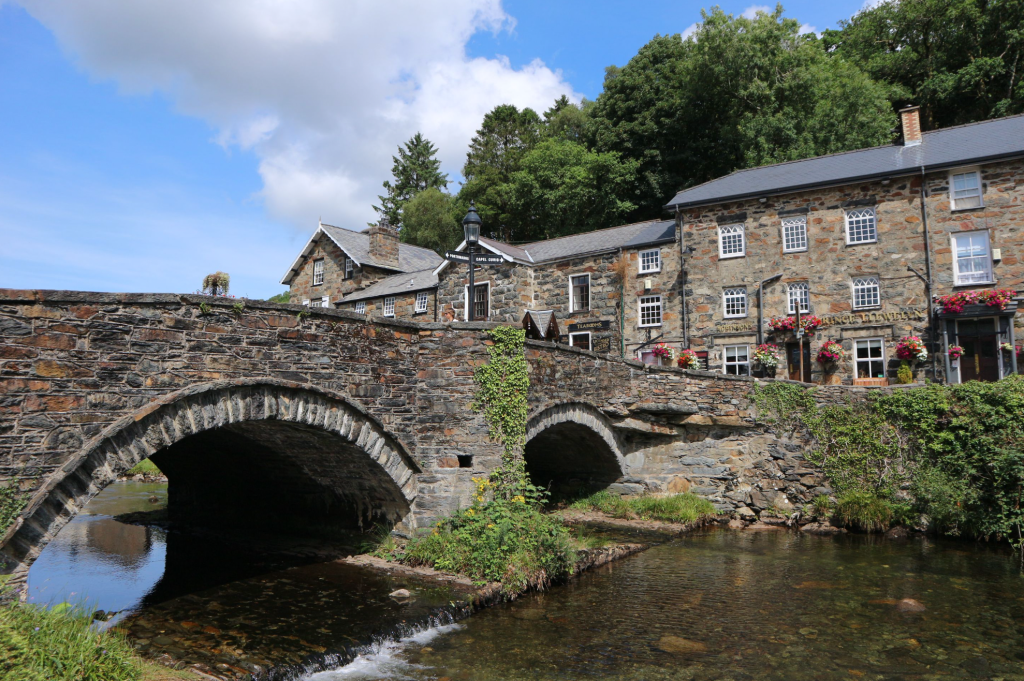
Riverside bites aren’t hard to find in Beddgelert. Credit: Will Renwick
While there might be plenty of reasons to stay within Beddgelert and its immediate environs, one of its greatest assets is its location right at the heart of the national park. This makes all corners of it, along with the coastline of Pen-Llyn, within relatively easy reach – whether that’s by car, bus or via the steam train linking Porthmadog to the south and Caernarfon to the north.
Learn more about having a jam-packed adventure weekend in Beddgelert from our Online Editor, Will Renwick.
A weekend adventure in Crickhowell, Bannau Brychieniog (Brecon Beacons)
Ridgetop adventures, a journey through Tolkein’s Shire and wild swims await. Phillipa Cherryson is your local guide.

The Llangattock escarpment. Credit: Shutterstock
To the south of the Black Mountains and with the River Usk flowing beneath its famous 17th century stone bridge, Crickhowell is an absolute gem. Independent shops, pubs and cafes line its High Street; you can picnic next to the remains of its 13th century castle, or walk up to Crug Hywel, the Iron Age hillfort, which gives the town its name.
Unsurprisingly, it is a popular place for visitors, and the pavements are regularly filled with walkers heading off into the surrounding countryside. The Crickhowell Walking Festival is held in March and it’s also home to the Green Man Festival in August.
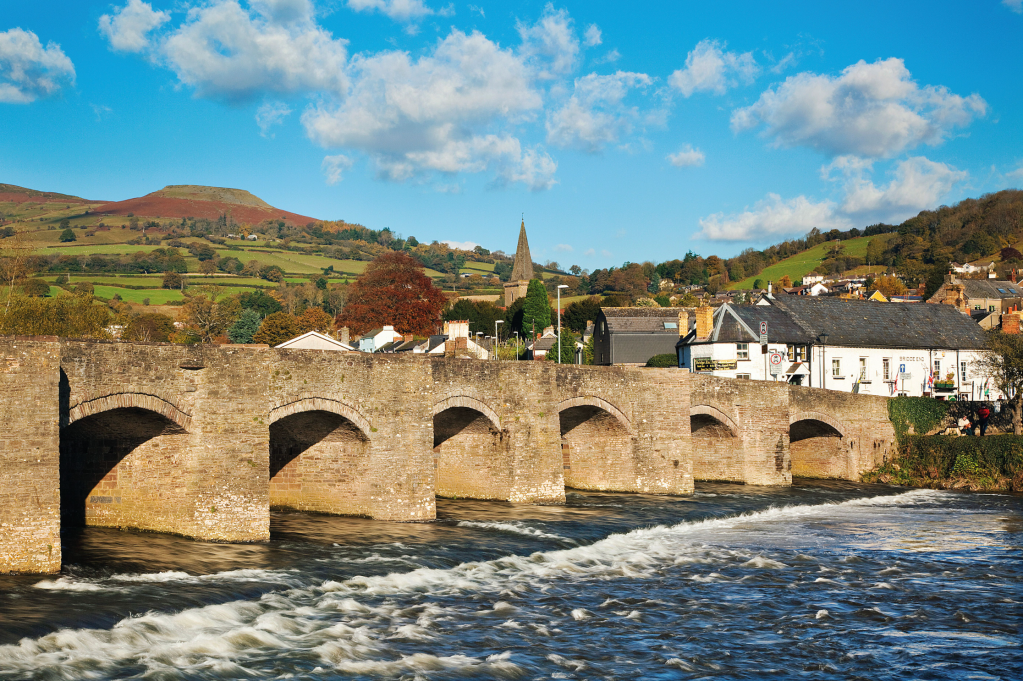
The old bridge in Crickhowell. Credit: Shutterstock
By way of facilities, walkers will want for nothing. Crickhowell Resource and Information Centre (01873 811970) is on the main A40 through town. The pay and display car park is at the rear it and it also has toilets and an art gallery.
The compact Georgian town centre has a wide variety of places to stock up on supplies, including two butchers, a petrol station, two grocers, a wine shop and an outdoor gear shop, Crickhowell Adventure which will be familiar with those who follow the annual TGO Reader Awards!
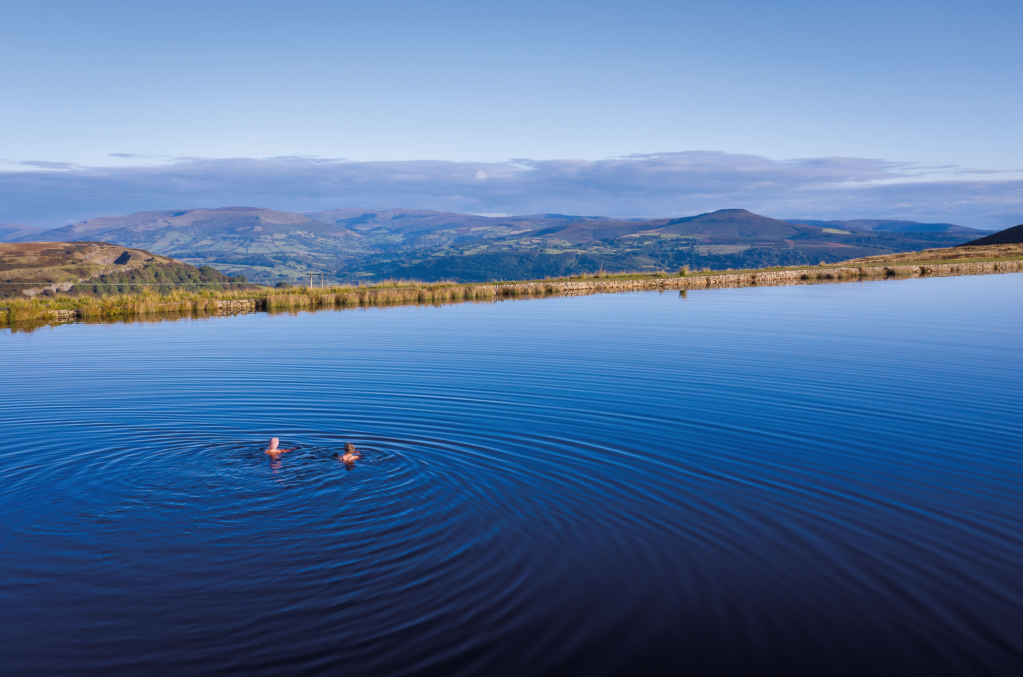
The Keepers’ Pond. Credit: Shutterstock
You’ll be spoilt for choice in the surrounding countryside too. The 99-mile Beacons Way and 298-mile Cambrian Way both skirt the town. But if those sound a little too time-consuming, you can stroll, cycle or paddle along the Brecon and Monmouth Canal, go rock climbing or caving on the Llangattock escarpment or just laze in the riverside Bullpit Meadows.
There’s so much to see and do that you won’t fit it all into a single weekend – but there’s always next time.
Learn more about having a jam-packed adventure weekend in Crickhowell from Phillipa Cherryson.
A weekend adventure in Castleton, Peak District
Here’s our guide to having the best possible adventurous weekend in Castleton. Our Content Producer and Peak District-dweller, Francesca Donovan, takes care of your itinerary.
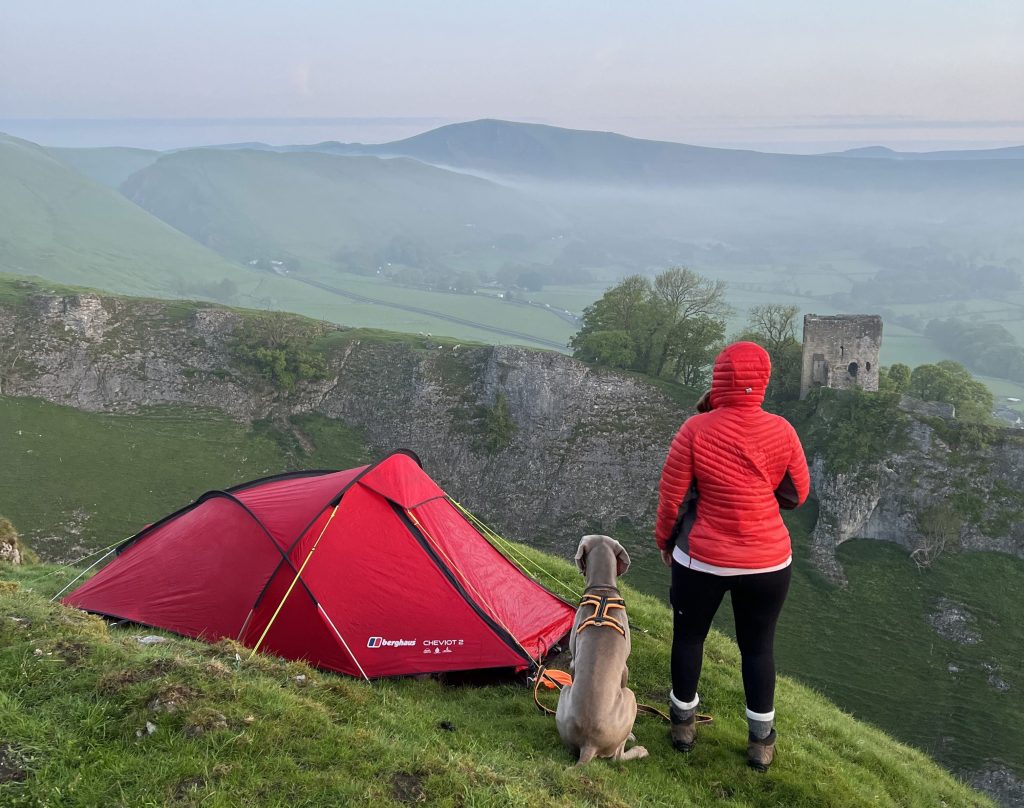
A wild camp above Peveril Castle in the Peak village of Castleton. Credit: Francesca Donovan
Slap bang in the centre of our first national park, Castleton is nestled between the Peak District’s highest places and (arguably) it’s finest hillwalking. It may well be the Peak District’s worst kept secret. Surrounded by picture-postcard scenes beloved by landscape photographers, this village sits pretty in the embrace of the hillwalking high points of our first national park. Locals may roll their eyes at its packed pavements and populated pub beer gardens, especially during school holidays, but it’s easy to explain its mass appeal.
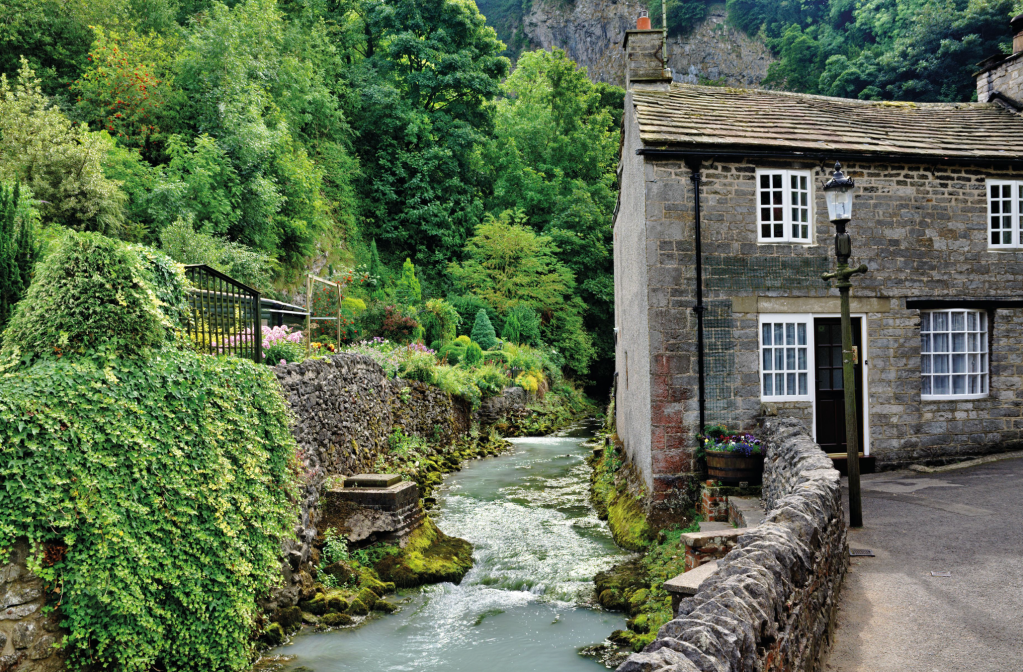
The oft-photographed riverside cottage in Castleton. Credit: Shutterstock
From the town – a quintessentially English collection of quaint stone cottages and cafes – footpaths will take you directly up into the rolling hills, steep gorges and expansive moorland plateaus. From here, you may glimpse a mountain hare – the only UK population outside the Scottish highlands – a red deer, perhaps a ring ouzel or a peregrine. It doesn’t take long for you to reach those big sky wildlife habitats and scenic vistas. Part of the beauty of the Peak is the compact proximity of some of its finest views, making many of the walking routes family-friendly. In fact, all you need to do is raise your eyes from your morning coffee and from pretty much any place in the village, your gaze will be drawn to a new trail.
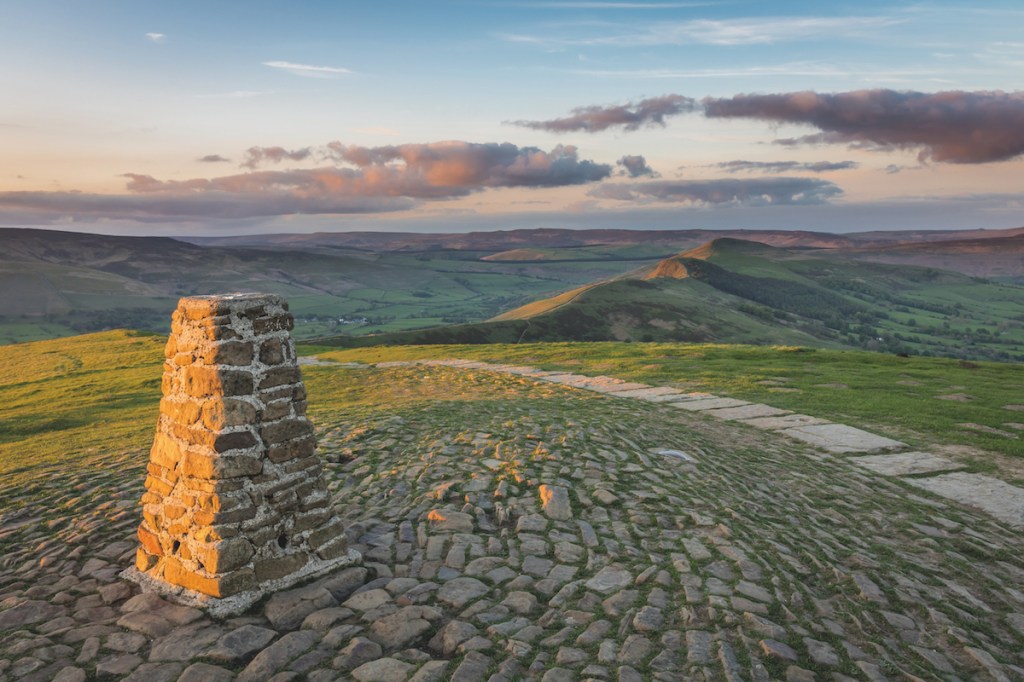
The trig point at Mam Tor looking along The Great Ridge above Castleton. Credit: Shutterstock
It’s just a stone’s throw from the start of the Pennine Way – one of the most gruelling long distance walks in England – which begins over in neighbouring Edale. Yet, from Castleton, you can enjoy the hillwalking high life in cushy comfort with plenty of well signposted circulars which will deliver you back within spitting distance of a gift shop in a matter of hours. The accessibility of Castleton is only compounded by the fact that an estimated 20 million people live within an hour’s travel time of the Peak District. Indeed, the Peak District welcomes more than 13 million people each year. But this is a living landscape where community and cultural traditions like the well dressing live on. Come and join us for the weekend and see how much adventure you can pack in.
Learn more about having a jam-packed adventure weekend in Castleton from Francesca Donovan.
Postbridge, Dartmoor
It might be tiny, but sat slap in the middle of Dartmoor, Postbridge punches way above its weight when it comes to providing a base for a weekend’s upland exploration. Tim Gent sets the moorland scene.
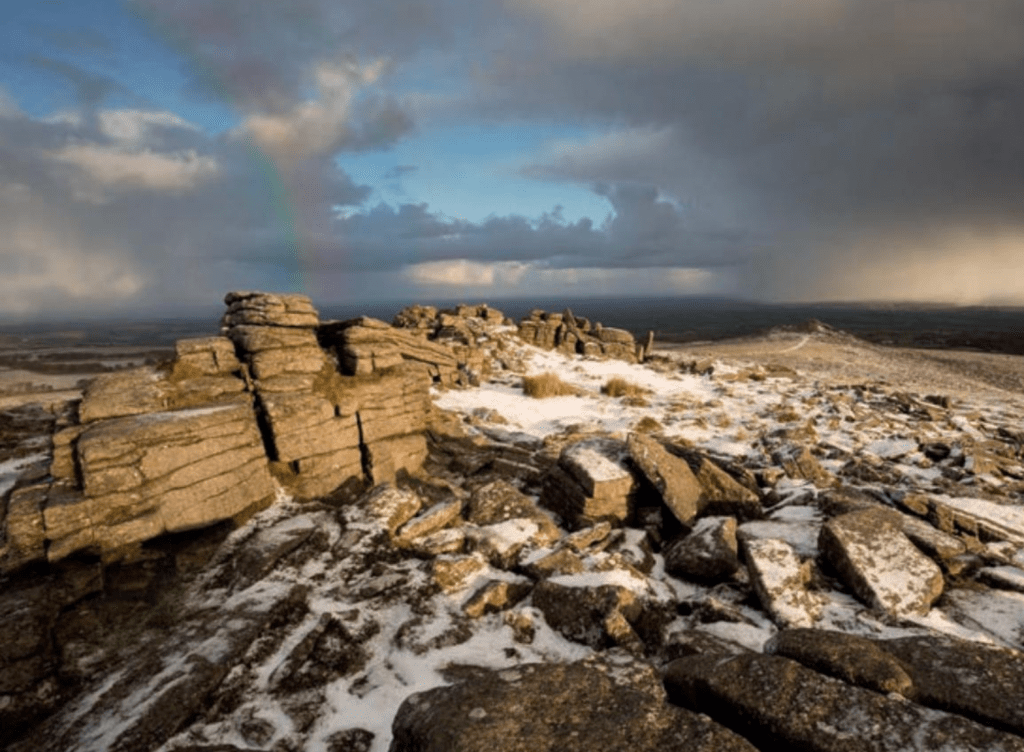
Belstone Tor in the snow. Credit: Shutterstock
Dig out a map of Dartmoor National Park, stick your finger right in the middle, and you’ve found Postbridge. Mind you, that fingertip will probably cover the entire settlement, for Postbridge is hardly big. Stretched out thin along one of the only sizable roads to cross the moor, it boasts a population of little more than 300. But it’s the location that counts, and this friendly moorland hamlet, high among the folded granite hills, puts you right on the doorstep of an almost unlimited range of fine upland walks.
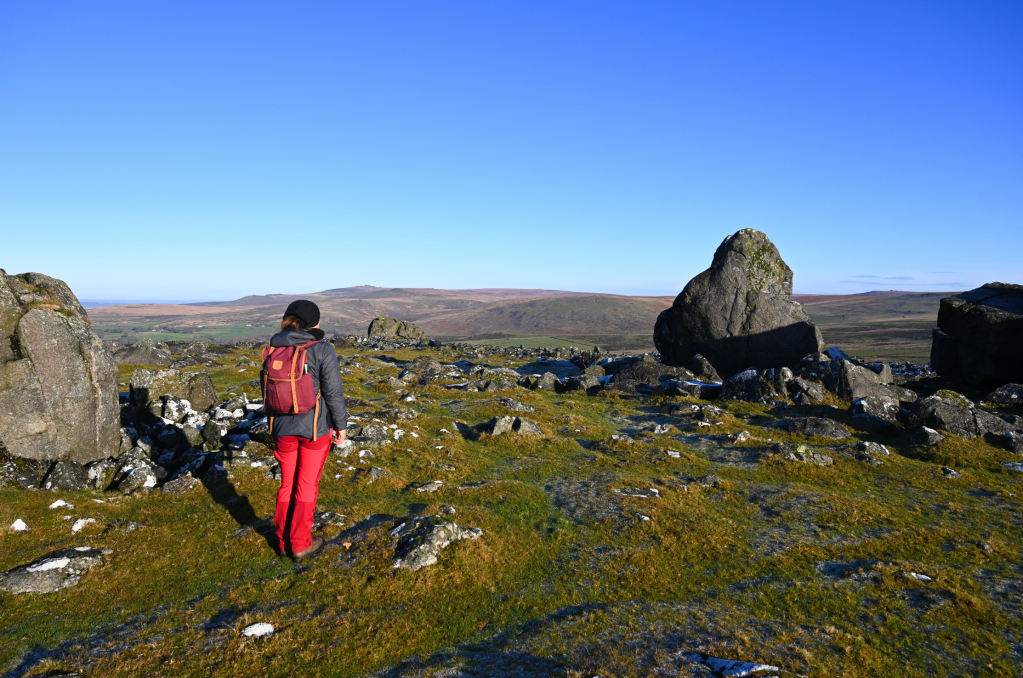
Looking out from White Tor. Credit: Tim Gent
Because of its privileged position, Postbridge also brings in the crowds, so while a motorist keen to reach Tavistock or Moretonhampstead might blink and almost miss the sparse scatter of buildings, the settlement possesses just about everything a visiting walker might need: a large car park, a brand-new National Park visitor centre, a pub, hotels and bunkhouse, even a small post office and store.
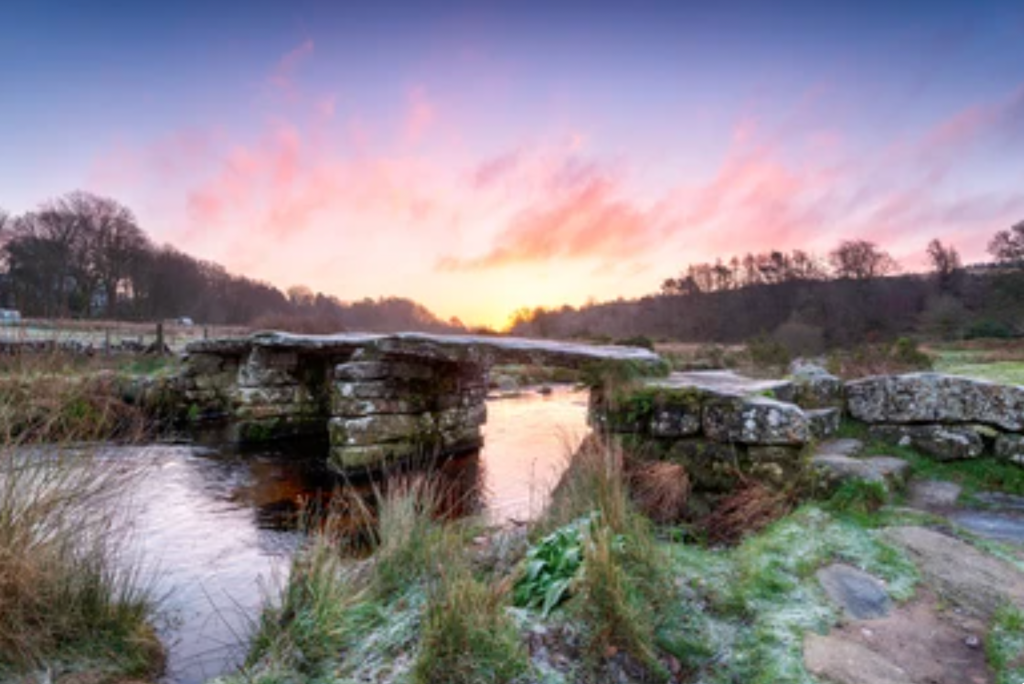
The Clapper Bridge at Postbridge. Credit: Shutterstock
At its heart also lies what must be one of the most photographed upland river crossings in southern England. Perhaps built as early as the 13th century, the bare granite slabs of Postbridge’s ‘clapper’ bridge, provide an open and very scenic walkway over the East Dart River.
Learn more about having a jam-packed adventure weekend in Postbridge from Tim Gent.







